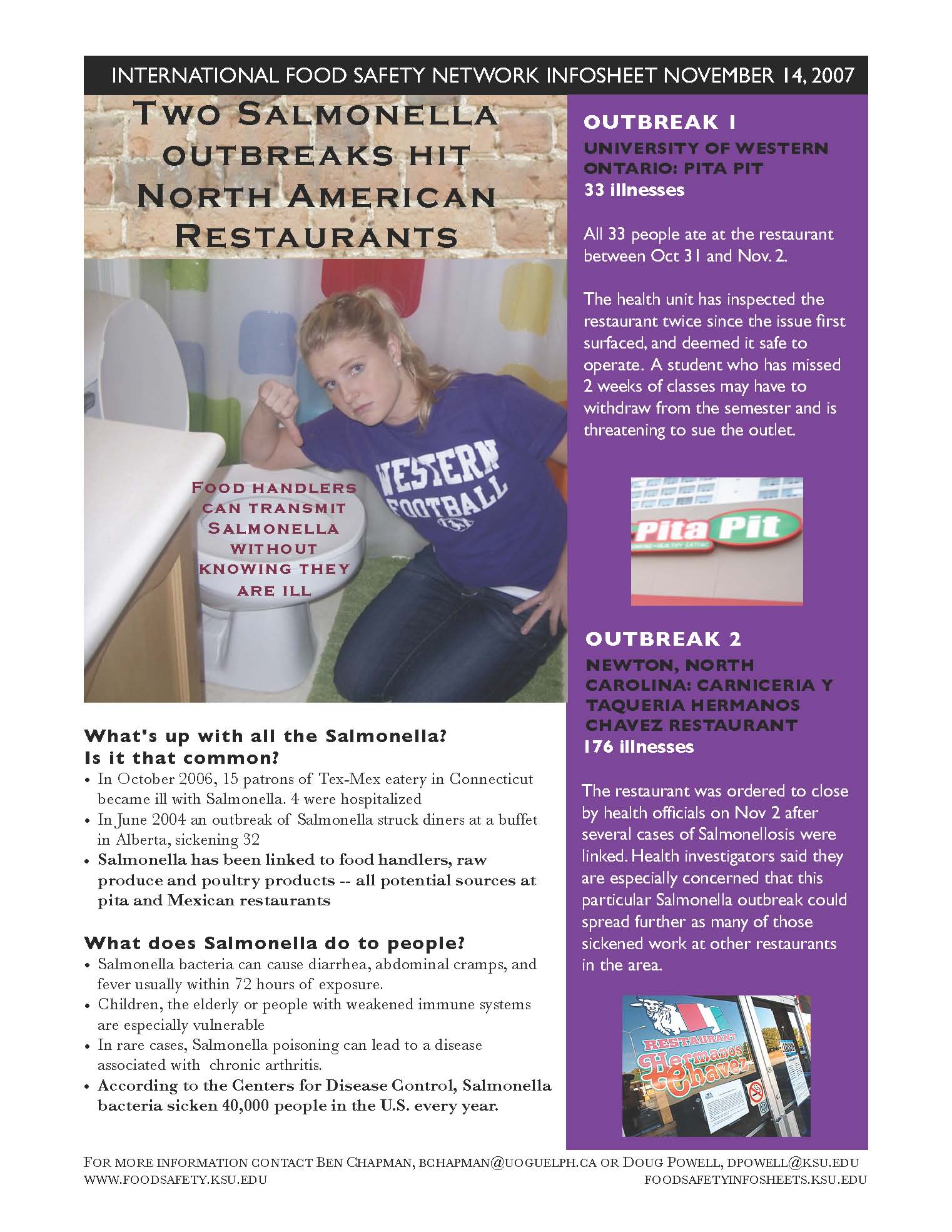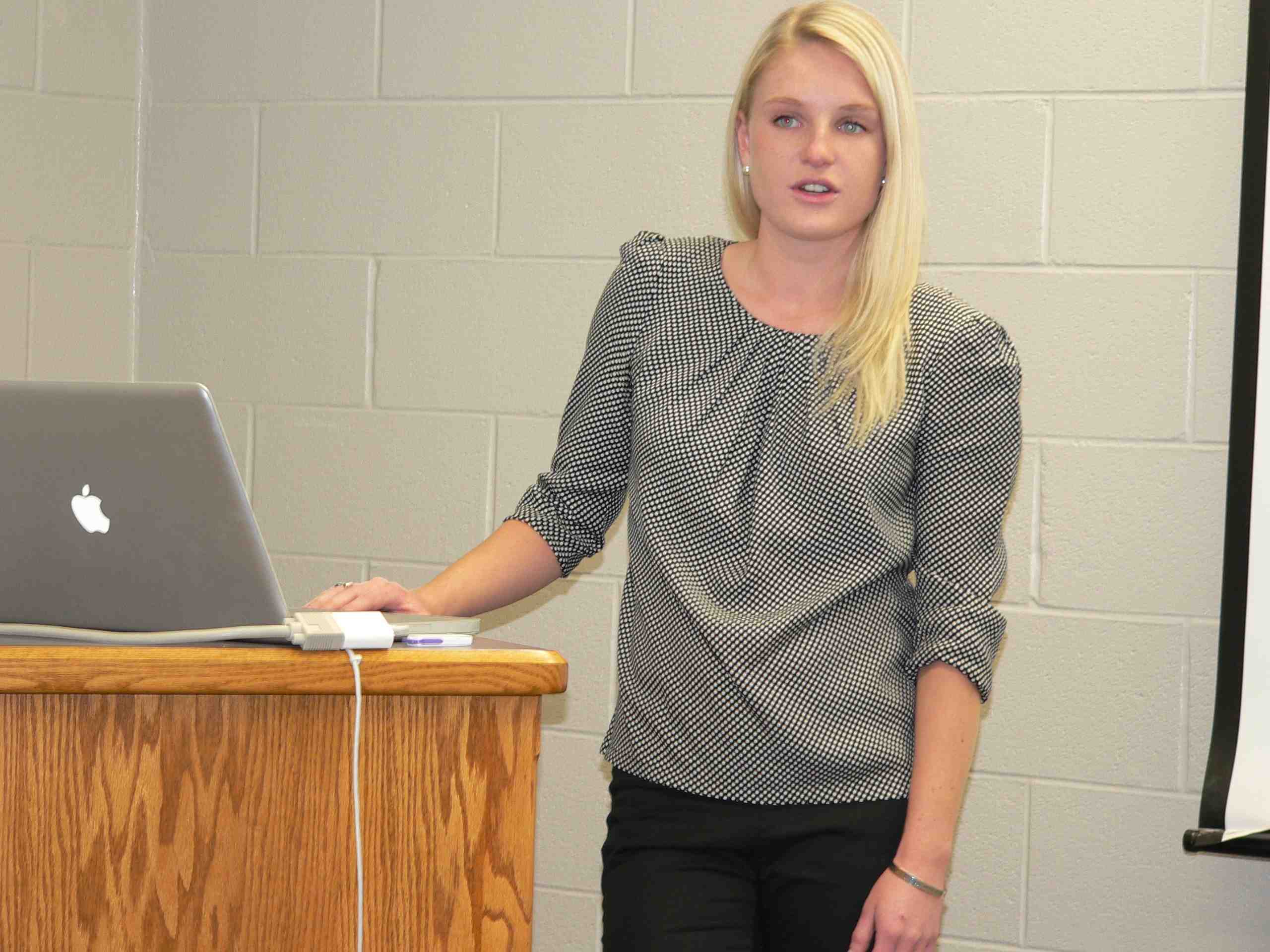Katie Filion and Brandon Speight, students in my food safety reporting class, write,
There is nothing appetizing about dead rodents, crusty slicers or sewage in a restaurant kitchen, but these are problems the Riley County Department of Health and Environment, in Manhattan, Kansas, has encountered during recent restaurant inspections. So how does a consumer, unable to witness what goes on behind the kitchen door, make an informed dining decision?
.jpg) Perhaps unknown to some, restaurant inspection information is publicly available online in Kansas. After reviewing this data a few eateries appear to be dirtier than others, but what constitutes a bad inspection?
Perhaps unknown to some, restaurant inspection information is publicly available online in Kansas. After reviewing this data a few eateries appear to be dirtier than others, but what constitutes a bad inspection?
Kathy Brower, an inspector for Riley County, answered some questions about the inspection process, and didn’t skip the dirty details.
Brower explained that foodservice establishments in Kansas are required to be inspected at least once a year. If a consumer contacts the health department with a complaint the establishment must be inspected within 24 hours. On the department website, consumers can see when an establishment has been inspected, and whether it was a routine inspection, customer complaint, or follow-up to address previous issues.
Brower additionally explained that during the inspection process the health inspector is looking for several things, some of which are categorized as non-critical violations and others as critical violations, and are based on likelihood to cause illness.
“Examples of non-critical violations are things like mildew issues, thawing messes or dust,” said Brower. “Critical violations are more based on health risk, like hot or cold holding temperatures, ensuring clean food contact surfaces, pest control, and proper food handling.“
Critical violations — the problems that have a higher risk of making someone sick– are enforced on a three-strike rule.
“[An establishment] is given a violation, and has two chances to correct this violation before they are assigned a fine. Fines range in severity, and are based on the type of violation. They can be between $100-500 per violation,” explained Brower.
What’s the grossest thing Brower’s ever seen during an inspection?
“Raw sewage backed-up in a kitchen, a wall-mounted veggie slicer that hadn’t been cleaned in over a year, and mice. There are so many different things it’s hard to say…There’ve been several instances of mold and mildew in bad places.”
So which restaurants in Manhattan are the dirtiest? Brower wouldn’t say, but after reviewing the inspection results online, a few appear to have more problems than others. To be considered a dirty diner an establishment had to have several violations, with a high number of critical violations, repeat violations or customer complaints being a red flag.
With inspection results for over 250 foodservice establishments in Riley County listed on the department website, it is difficult to pinpoint only three that fared the worst. The website includes results for all foodservice operations, including schools and hotels, not considered in the search for Manhattan’s dirtiest diner.
In the end, the three restaurants in Manhattan that appear dirtiest are: Grizzly’s Grill, Bobby T’s and Hunam Express.
When asked if inspection is a good thing, Anthony Parker, owner of Grizzly’s Grill, who landed on the list because of last year’s inspection with a whopping 11 critical violations and repeat pest problems, said, “Yes and no. Every time there’s a new health inspector things change. I could be doing something one way for 5 years, and a new inspector decides they don’t like that. Then I get written up.”
Parker explained he feels the inspection process may not be fully understood by consumers.
“The biggest thing is when people read about violations and they aren’t educated about what [a violation] means they can sound worse than what they are. Based on the inspection criteria you could go into any consumer’s household and shut them down.”
When asked about the critical violations found during last year’s inspection, Parker added, “[Critical violations] are corrected on site. A lot of the repeat [violations] come from turn over of staff… I could tell them until I’m blue in the face, but until inspection they don’t realize it’s the law they need to follow, and I say things for a reason.”
Should inspection results be available to the public? Parker feels there are some holes in the disclosure system,
“It depends on how bad you did. The last [inspection], I wish it would disappear… but I would prefer more of an explanation for consumers. For example, temperature violations are usually a degree or two off, but that doesn’t appear on the website.”
Overall Parker says the poor inspection ranking on the website has negatively affected business.
Bobby T’s landed on the dirty dining list for last year’s July inspection with 8 critical violations, and several inspections throughout the year. Though Greg Bollenbach, co-owner of Bobby T’s, didn’t wish to comment on any of the previous inspections, he did say the inspection process is both necessary and beneficial.
“You’ve got to do it. What [inspection] does is heightens your awareness. If they come in and find a problem with the hold temperatures of one food item it alerts you, and makes you check all your stuff. Overall it improves product safety and quality. And in the end, it’s a learning process for everyone,” explained Bollenbach.
The third restaurant on this dirty dining list, Hunam Express, was inspected seven times last year, four of which in response to customer complaints. Numerous critical violations were observed during nearly all of these inspections, including issues with employee handwashing. No one at the establishment was available for contact.
Though health inspector Brower didn’t give an opinion on the dirtiest diner in Manhattan, she did indicate that corporate establishments usually fair better than privately owned operations. Is this always the case? No, but this time around a corporately owned foodservice establishment didn’t land amoung the dirtiest diners in Manhattan. Why?
Kirk Keling, general manager of Applebee’s in Manhattan, who has had it’s fair share of violations in the past, explained that the health department isn’t the only one to inspect Applebee’s.
“We’re inspected quarterly by operations, semi-annually by Applebee’s, and then at least once a year by the health department,” explained Keling.
But would more inspections result in fewer violations? Unlikely. Is the information on the health department website enough for consumers to make a decision based on? Maybe, but as Brower explained, it is important to recognize that inspection is only a snapshot in time, and an establishment with one violation may not necessarily be safer than an establishment with five.
Regardless of where consumers chose to eat, having the information available online provides choice – those who wish to learn more about their local diner can check the website, and those who could care less, won’t.
Katie Filion and Brandon Speight were students in a food safety reporting class this past semester at Kansas State University
Restaurant inspection reports are available at:
http://kensas.kdhe.state.ks.us/pls/certop/FSresults4?SelStr=(psnam=;pcnty=;pcity=Manhattan;)
 and, will be a graduate of biomedical sciences in the veterinary college at Kansas State University. As soon as we turn in the paperwork.
and, will be a graduate of biomedical sciences in the veterinary college at Kansas State University. As soon as we turn in the paperwork. food safety is pretty good. But when someone screws up, it’s pretty bad."
food safety is pretty good. But when someone screws up, it’s pretty bad."

 And I have to be more sensitive – I wanted to call this blog post, The shocking, untold, no-holds barred story of how Katie Filion went from Sault St. Marie, to Guelph, to Manhattan (Kansas) to New Zealand.
And I have to be more sensitive – I wanted to call this blog post, The shocking, untold, no-holds barred story of how Katie Filion went from Sault St. Marie, to Guelph, to Manhattan (Kansas) to New Zealand. .jpg) In May, it was off to Wellington, NZ, and she seems to be doing great; even got a review paper published, which just came out.
In May, it was off to Wellington, NZ, and she seems to be doing great; even got a review paper published, which just came out.
.jpg) Perhaps unknown to some, restaurant inspection information is publicly available
Perhaps unknown to some, restaurant inspection information is publicly available .jpg) Katie Filion will be giving a departmental seminar this afternoon about restaurant inspection disclosure systems, research needs, and how to make them better. Katie’s been accepted into graduate school at Kansas State beginning in May 2009, and is working in my lab until then.
Katie Filion will be giving a departmental seminar this afternoon about restaurant inspection disclosure systems, research needs, and how to make them better. Katie’s been accepted into graduate school at Kansas State beginning in May 2009, and is working in my lab until then. One of the elements of the presentation was demonstrating proper handwashing technique, and for how long to wash your hands. Like the article in the
One of the elements of the presentation was demonstrating proper handwashing technique, and for how long to wash your hands. Like the article in the .jpg) Katie Filion is a soon-to-be graduate student at Kansas State University who currently resides in Doug and Amy’s basement.
Katie Filion is a soon-to-be graduate student at Kansas State University who currently resides in Doug and Amy’s basement. "The patron complained about employees coughing on food, improper employee hand washing and a lack of hot water. A visit by the health inspector the next day didn’t reveal any violations, but it was recommended the restaurant review food education and handling practices with its employees. After a follow-up inspection resulted in a charge for lack of sanitizer in the mechanical glass washer, vice-president of operations at East Side Mario’s decided to close the restaurant. Employees from East Side Mario’s head office were sent in to help the local site return to company standards.
"The patron complained about employees coughing on food, improper employee hand washing and a lack of hot water. A visit by the health inspector the next day didn’t reveal any violations, but it was recommended the restaurant review food education and handling practices with its employees. After a follow-up inspection resulted in a charge for lack of sanitizer in the mechanical glass washer, vice-president of operations at East Side Mario’s decided to close the restaurant. Employees from East Side Mario’s head office were sent in to help the local site return to company standards. Katie Filion is a soon-to-be graduate student at Kansas State University who currently resides in Doug and Amy’s basement.
Katie Filion is a soon-to-be graduate student at Kansas State University who currently resides in Doug and Amy’s basement.